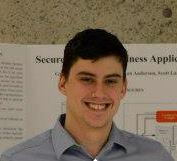
Ryan Anderson
Masters Student
Queen’s University
Member from 2013 to 2015
Ryan Anderson received his BSc in Electrical Engineering from Queen’s University in Kingston, Ontario in 2013. He graduated with an MSc student at Queen’s. His research was on pose tracking with a combined accelerometer-magnetometer-gyroscope for ultrasound probes.
Anderson, Ryan; Lasso, Andras; Hashtrudi-Zaad, Keyvan; Fichtinger, Gabor
Investigation of permanent magnets in low-cost position tracking Conference
Proc. SPIE, 2016.
@conference{doi:10.1117/12.2217189,
title = {Investigation of permanent magnets in low-cost position tracking},
author = {Ryan Anderson and Andras Lasso and Keyvan Hashtrudi-Zaad and Gabor Fichtinger},
url = {http://dx.doi.org/10.1117/12.2217189},
doi = {10.1117/12.2217189},
year = {2016},
date = {2016-01-01},
urldate = {2016-01-01},
booktitle = {Proc. SPIE},
pages = {97862F-97862F-9},
abstract = {<p>PURPOSE: Low cost portable ultrasound systems could see improved utility if similarly low cost portable trackers were developed. Permanent magnet based tracking systems potentially offer adequate tracking accuracy in a small workspace suitable for ultrasound image reconstruction. In this study the use of simple permanent magnet tracking techniques is investigated to determine feasibility for use in an ultrasound tracking system. METHODS: Permanent magnet tracking requires finding a position input into a field model which minimizes the error between the measured field, and the field expected from the model. A simulator was developed in MATLAB to determine the effect of sources of error in permanent magnet tracking systems. Insights from the simulations were used to develop a calibration and tracking experiment to determine the accuracy of a simple and low cost permanent magnet tracking system. RESULTS: Simulation and experimental results show permanent magnet based tracking to be highly sensitive to errors in sensor measurements, calibration and experimental setup. The reduction in field strength of permanent magnets lowers with the cube of distance, which leads to very poor signal-to-noise ratios at distances above 20 cm. Small errors in experimental setup also led to high tracking error. CONCLUSION: Permanent magnet tracking was found to be less accurate than is clinically useful, and highly sensitive to errors in sensors and experimental setup. Sensor and calibration limitations make simple permanent magnet tracking systems a poor choice given the present state of sensor technology.</p>},
keywords = {},
pubstate = {published},
tppubtype = {conference}
}
<p>PURPOSE: Low cost portable ultrasound systems could see improved utility if similarly low cost portable trackers were developed. Permanent magnet based tracking systems potentially offer adequate tracking accuracy in a small workspace suitable for ultrasound image reconstruction. In this study the use of simple permanent magnet tracking techniques is investigated to determine feasibility for use in an ultrasound tracking system. METHODS: Permanent magnet tracking requires finding a position input into a field model which minimizes the error between the measured field, and the field expected from the model. A simulator was developed in MATLAB to determine the effect of sources of error in permanent magnet tracking systems. Insights from the simulations were used to develop a calibration and tracking experiment to determine the accuracy of a simple and low cost permanent magnet tracking system. RESULTS: Simulation and experimental results show permanent magnet based tracking to be highly sensitive to errors in sensor measurements, calibration and experimental setup. The reduction in field strength of permanent magnets lowers with the cube of distance, which leads to very poor signal-to-noise ratios at distances above 20 cm. Small errors in experimental setup also led to high tracking error. CONCLUSION: Permanent magnet tracking was found to be less accurate than is clinically useful, and highly sensitive to errors in sensors and experimental setup. Sensor and calibration limitations make simple permanent magnet tracking systems a poor choice given the present state of sensor technology.</p>
Anderson, Ryan; Lasso, Andras; Hashtrudi-Zaad, Keyvan; Fichtinger, Gabor
Proposed Feasibility Analysis of Low Cost Inertial Freehand Ultrasound Position Tracking Conference
ImNO, Toronto, Ontario, 2014.
@conference{Anderson2014,
title = {Proposed Feasibility Analysis of Low Cost Inertial Freehand Ultrasound Position Tracking},
author = {Ryan Anderson and Andras Lasso and Keyvan Hashtrudi-Zaad and Gabor Fichtinger},
url = {https://labs.cs.queensu.ca/perklab/wp-content/uploads/sites/3/2024/02/Anderson2014-poster.pptx},
year = {2014},
date = {2014-01-01},
urldate = {2014-01-01},
booktitle = {ImNO},
address = {Toronto, Ontario},
keywords = {},
pubstate = {published},
tppubtype = {conference}
}